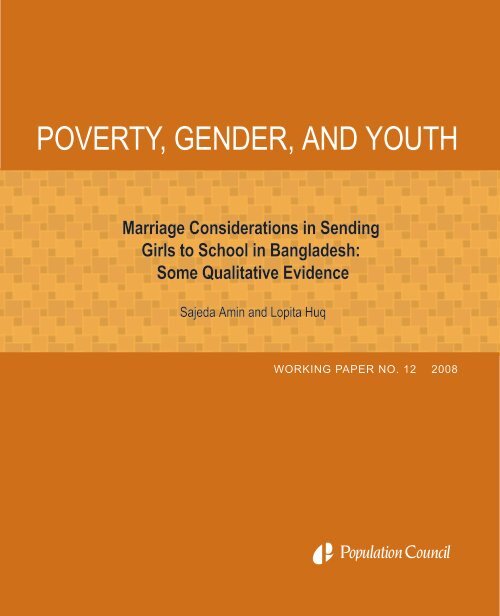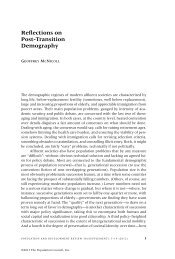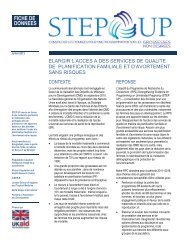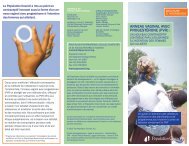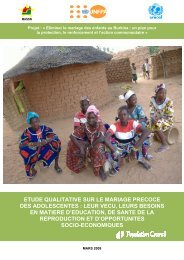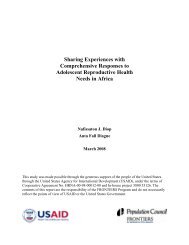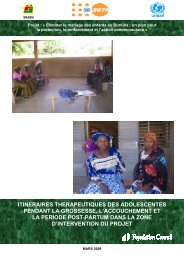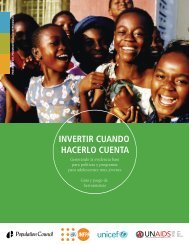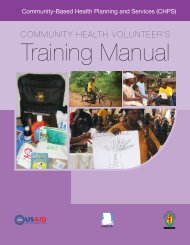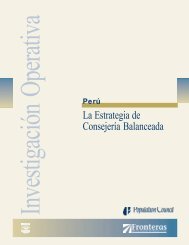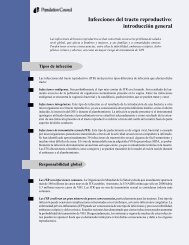Marriage Considerations in Sending Girls to School in Bangladesh ...
Marriage Considerations in Sending Girls to School in Bangladesh ...
Marriage Considerations in Sending Girls to School in Bangladesh ...
You also want an ePaper? Increase the reach of your titles
YUMPU automatically turns print PDFs into web optimized ePapers that Google loves.
POVERTY, GENDER, AND YOUTH<br />
<strong>Marriage</strong> <strong>Considerations</strong> <strong>in</strong> Send<strong>in</strong>g<br />
<strong>Girls</strong> <strong>to</strong> <strong>School</strong> <strong>in</strong> <strong>Bangladesh</strong>:<br />
Some Qualitative Evidence<br />
Sajeda Am<strong>in</strong> and Lopita Huq<br />
WORKING PAPER NO. 12 2008
One Dag Hammarskjold Plaza<br />
New York, New York 10017 USA<br />
www.popcouncil.org<br />
pub<strong>in</strong>fo@popcouncil.org<br />
For <strong>in</strong>formation on Poverty, Gender, and Youth work<strong>in</strong>g papers, see<br />
www.popcouncil.org/publications/wp/<strong>in</strong>dex.html<br />
This material may not be reproduced without written permission from the authors.<br />
ISSN: 1554-8538<br />
© 2008 The Population Council, Inc.
<strong>Marriage</strong> <strong>Considerations</strong> <strong>in</strong> Send<strong>in</strong>g <strong>Girls</strong> <strong>to</strong><br />
<strong>School</strong> <strong>in</strong> <strong>Bangladesh</strong>: Some Qualitative<br />
Evidence<br />
Sajeda Am<strong>in</strong><br />
Lopita Huq<br />
Sajeda Am<strong>in</strong> is Senior Associate, Program on Poverty, Gender, and Youth, Population<br />
Council, New York. E-mail: sam<strong>in</strong>@popcouncil.org. Lopita Huq is Consultant,<br />
Population Council, New York.<br />
This paper was made possible through support provided by the Department for<br />
International Development, U.K. (DfID); the Hewlett Foundation (#2005-6492 and 2001-<br />
1124); the Mellon Foundation; UNICEF, Dhaka; and the Office of Population and<br />
Reproductive Health, Bureau for Global Health, U.S. Agency for International<br />
Development, under the terms of Award No. HRN-A-00-99-00010. The op<strong>in</strong>ions<br />
expressed here<strong>in</strong> are those of the authors and do not necessarily reflect the views of the<br />
U.S. Agency for International Development.
ABSTRACT<br />
This paper analyzes parents‘ decisions about girls‘ school<strong>in</strong>g <strong>in</strong> the context of<br />
marriage through <strong>in</strong>-depth exploration of case studies <strong>in</strong> two rural areas of northern<br />
<strong>Bangladesh</strong>. The villages are sites of a long-term community study from 1991 and 2002,<br />
a time when significant changes were underway, partly as a result of new school<br />
<strong>in</strong>centive programs <strong>in</strong>troduced <strong>in</strong> 1994. The data show that the rise of dowry demands, a<br />
relatively recent practice that is barely a generation old among Muslims <strong>in</strong> these areas,<br />
asserts an important and <strong>in</strong>dependent <strong>in</strong>fluence on marriage decisions and <strong>in</strong>directly<br />
<strong>in</strong>fluences decisions about school<strong>in</strong>g. The <strong>in</strong>fluence of programs such as secondary<br />
school scholarships for girls is best viewed <strong>in</strong> the context of familial concerns about<br />
marriage and dowry.
Several <strong>in</strong>dica<strong>to</strong>rs of educational atta<strong>in</strong>ment suggest that significant changes related <strong>to</strong><br />
school<strong>in</strong>g have taken place <strong>in</strong> <strong>Bangladesh</strong>. Start<strong>in</strong>g at very low levels at the time <strong>Bangladesh</strong> became<br />
<strong>in</strong>dependent <strong>in</strong> 1971, primary education is now universal, with a school <strong>in</strong> every village. Secondary<br />
school attendance is also high. The data suggest that mass education is now established <strong>in</strong><br />
<strong>Bangladesh</strong>.<br />
<strong>Marriage</strong> market dynamics have also changed. A well-documented rise has occurred <strong>in</strong> the<br />
practice of dowry—payments by a bride‘s family <strong>to</strong> the groom or his family—and a considerable<br />
<strong>in</strong>flation is seen <strong>in</strong> dowry demands, replac<strong>in</strong>g a cus<strong>to</strong>m of bride price, the flow of payments <strong>in</strong> the<br />
opposite direction. The phenomenon is relatively recent <strong>in</strong> <strong>Bangladesh</strong> and mimics trends described<br />
throughout India among groups that did not traditionally practice dowry, such as lower caste H<strong>in</strong>dus<br />
<strong>in</strong> the north and H<strong>in</strong>dus <strong>in</strong> the south Indian state of Karnataka (Sharma 1980; Rao 1993a, 1993b).<br />
The first dowry payments <strong>in</strong> the <strong>Bangladesh</strong>i villages we study <strong>in</strong> this paper were reported around<br />
the 1960s (Am<strong>in</strong> and Ca<strong>in</strong> 1997). The practice of dowry was made illegal by a law passed <strong>in</strong> 1985<br />
by the Government of <strong>Bangladesh</strong>.<br />
Rapid school<strong>in</strong>g changes, beg<strong>in</strong>n<strong>in</strong>g <strong>in</strong> the late 1980s and early 1990s, <strong>to</strong>ok place somewhat<br />
later than the rise of dowry. <strong>Girls</strong>‘ school attendance rose faster than boys‘, and there is now near<br />
gender equity <strong>in</strong> the first ten years of school (World Bank 2008). These changes likely are<br />
attributable <strong>to</strong> programs and policies <strong>in</strong> the education sec<strong>to</strong>r that attempt <strong>to</strong> close the gender gap.<br />
These have <strong>in</strong>cluded enrollment drives that target girls, free tuition for girls while boys are required<br />
<strong>to</strong> pay, and, most recently, monetary <strong>in</strong>centive programs that reward families for send<strong>in</strong>g girls <strong>to</strong> and<br />
keep<strong>in</strong>g them <strong>in</strong> secondary school. These <strong>in</strong>centive programs are especially aimed at rais<strong>in</strong>g age at<br />
marriage by promot<strong>in</strong>g cont<strong>in</strong>ued education and thereby encourag<strong>in</strong>g later marriages and <strong>in</strong> turn<br />
lower fertility. One requirement of the programs is that parents sign a pledge that they will not marry<br />
off their enrolled daughters before 18 years of age.<br />
There is compell<strong>in</strong>g evidence, nevertheless, that the persistence of early marriage poses a<br />
critical challenge <strong>to</strong> ensur<strong>in</strong>g full gender equity <strong>in</strong> education. <strong>Girls</strong> drop out at a faster rate than boys<br />
after the tenth year of school (Mahmud and Am<strong>in</strong> 2006). A recent survey of adolescents shows that<br />
only 10 percent of girls who completed primary school passed the secondary school certificate<br />
exam<strong>in</strong>ation compared <strong>to</strong> 25 percent of boys (<strong>Bangladesh</strong> Adolescent Survey, authors‘ calculation).<br />
Two recent papers explore how marriage decisions about school dropout for girls vary with<br />
household economic status. <strong>Girls</strong> <strong>in</strong> wealthier families are more likely <strong>to</strong> drop out because of<br />
marriage, while poor girls drop out for other reasons (Mahmud and Am<strong>in</strong> 2006). Schuler and<br />
colleagues (2006) exam<strong>in</strong>e qualitative evidence of divergent marriage strategies for the poor and<br />
wealthy <strong>in</strong> rural <strong>Bangladesh</strong> and suggest that norms favor<strong>in</strong>g early marriage are erod<strong>in</strong>g faster<br />
among wealthy families because of chang<strong>in</strong>g gender ideals and aspirations.<br />
This paper explores the <strong>in</strong>terrelationships between education and the tim<strong>in</strong>g and quality of<br />
marriage, <strong>in</strong>clud<strong>in</strong>g prospects for marriage, the ―price‖ of husbands, and the <strong>in</strong>fluence of monetary<br />
<strong>in</strong>centives on the tim<strong>in</strong>g of marriage. The data come from an <strong>in</strong>tensive study conducted <strong>in</strong> two<br />
villages <strong>in</strong> Mohanpur thana located <strong>in</strong> Rajshahi district <strong>in</strong> northwest <strong>Bangladesh</strong>. Like the rest of<br />
rural <strong>Bangladesh</strong>, the two villages are agro-based, largely Muslim communities and have<br />
3
experienced considerable social and demographic change <strong>in</strong> education, family plann<strong>in</strong>g services,<br />
women‘s development programs, and child health services.<br />
BACKGROUND<br />
Education can affect women‘s lives through multiple pathways <strong>in</strong> which marriage can play a<br />
key mediat<strong>in</strong>g role. Studies from contemporary South Asian societies show that education may<br />
improve women‘s barga<strong>in</strong><strong>in</strong>g position as a valued marriage market attribute (Rao 1993b); it may<br />
facilitate delay <strong>in</strong> marriage by giv<strong>in</strong>g women a legitimate reason <strong>to</strong> rema<strong>in</strong> s<strong>in</strong>gle after puberty<br />
(Am<strong>in</strong> 1996); education may <strong>in</strong>crease women‘s au<strong>to</strong>nomy by giv<strong>in</strong>g them a greater decisionmak<strong>in</strong>g<br />
role with<strong>in</strong> the natal family and allow<strong>in</strong>g them <strong>to</strong> articulate their preferences about marriage,<br />
<strong>in</strong>clud<strong>in</strong>g when and whom <strong>to</strong> marry (Mason 1984; Jejeebhoy 1995); and education can provide<br />
married women with negotiat<strong>in</strong>g skills or barga<strong>in</strong><strong>in</strong>g power with<strong>in</strong> the conjugal relationship (Sathar<br />
1996).<br />
Most studies of education‘s <strong>in</strong>fluence on changes <strong>in</strong> women‘s status have taken place <strong>in</strong><br />
contexts where educational ga<strong>in</strong>s occurred for boys as well as for girls. Explor<strong>in</strong>g data from<br />
<strong>Bangladesh</strong> for a time period preced<strong>in</strong>g the gender-differentiated school<strong>in</strong>g <strong>in</strong>terventions of the<br />
1990s, Am<strong>in</strong> and Lloyd (2002) found that spousal gender gaps rema<strong>in</strong>ed rigid even as overall levels<br />
of women‘s education rose. There have been few evaluations of the <strong>in</strong>fluence of ris<strong>in</strong>g education for<br />
girls relative <strong>to</strong> boys because reduction <strong>in</strong> the gender gap <strong>in</strong> education is a recent phenomenon <strong>in</strong><br />
<strong>Bangladesh</strong> and other develop<strong>in</strong>g countries (NRC 2005). One exception is a World Bank survey<br />
conduct <strong>in</strong> 2006 <strong>in</strong> <strong>Bangladesh</strong> show<strong>in</strong>g that married women born between 1981 and 1991 are more<br />
likely <strong>to</strong> marry men with less education than themselves relative <strong>to</strong> women born between 1946 and<br />
1961 (World Bank 2008).<br />
Recent work on India and <strong>Bangladesh</strong> explores the specific question of <strong>in</strong>terest <strong>in</strong> this paper,<br />
namely how education affects marriage market dynamics (Rao 1993a, 1993b; Edlund 2000).<br />
Behrman and colleagues (1999) exam<strong>in</strong>e more far-reach<strong>in</strong>g outcomes of marriage by look<strong>in</strong>g at the<br />
implications of spousal characteristics for child welfare. Hallman (2000) follows a similar approach.<br />
While the literature has been <strong>in</strong>formative <strong>in</strong> many ways, there is disagreement about how<br />
education affects the prospects for marriage or the price paid for husbands. Rao (1993b) and<br />
Behrman et al. (1999) suggest that education substitutes for dowry, whereas Edlund (2000) and<br />
Hallman (2000) provide evidence <strong>to</strong> support the premise that education complements dowry, thus<br />
reduc<strong>in</strong>g the amounts paid. Our own assessment is premised on the notion that some of the<br />
disagreement <strong>in</strong> the literature may be resolved through a more nuanced understand<strong>in</strong>g of the process<br />
of marriage negotiations. The methodology is descriptive and relies primarily on qualitative<br />
evidence.<br />
We take <strong>in</strong><strong>to</strong> account the notion that perceptions about the marriage market may be as<br />
important as the realities themselves. Kabeer (2001) suggests that the concept of ―habitus‖ used by<br />
Bourdieu <strong>to</strong> ―capture the socially structured subjectivity <strong>in</strong> social practice‖ is appropriate <strong>in</strong> this<br />
context. In <strong>Bangladesh</strong>, behavior, practice, and aspirations are accommodated with<strong>in</strong> a set of<br />
objective possibilities offered by the social context and are governed by the community‘s code of<br />
4
conduct. However, this does not preclude the role of agency, as is suggested by our emphasis on<br />
social and cultural structures. Rather <strong>in</strong>dividuals operate with<strong>in</strong> the habitus and seek <strong>to</strong> maximize<br />
their <strong>in</strong>terests while adher<strong>in</strong>g <strong>to</strong> the rules and norms of society. In this context agency becomes more<br />
closely associated with the <strong>in</strong>terpretation of rules, and <strong>in</strong>dividual <strong>in</strong>terests determ<strong>in</strong>e how the rules<br />
are <strong>in</strong>terpreted. Thus even while work<strong>in</strong>g with<strong>in</strong> a given framework, the self-<strong>in</strong>terested <strong>in</strong>terpretation<br />
of rules and the deployment of strategies <strong>to</strong> serve those <strong>in</strong>terests give rise <strong>to</strong> a diversity of outcomes.<br />
As long as these behaviors and strategies are accommodated with<strong>in</strong> the ―sense of limits‖ <strong>in</strong>voked by<br />
the habitus, no change <strong>in</strong> the social order can be expected.<br />
METHOD AND DATA<br />
We address these issues through <strong>in</strong>-depth case studies of recent marriages, with a focus on<br />
the details of the marriage process. In the study area the process consists of the receipt of marriage<br />
proposals, marriage negotiations <strong>in</strong>clud<strong>in</strong>g agreement on amount of dowry, and the events<br />
immediately preced<strong>in</strong>g and follow<strong>in</strong>g the marriage. Case studies are based on <strong>in</strong>terviews with<br />
married and unmarried young women and available members of her family and her husband‘s<br />
family. The <strong>in</strong>terviews focus on issues perta<strong>in</strong><strong>in</strong>g <strong>to</strong> education and school<strong>in</strong>g, particularly as they are<br />
discussed <strong>in</strong> the context of marriage. Our experience with gather<strong>in</strong>g <strong>in</strong>formation on education has<br />
shown that values and attitudes that appear relatively vague <strong>in</strong> general discussions tend <strong>to</strong> come <strong>in</strong><strong>to</strong><br />
sharper focus <strong>in</strong> the context of marriage.<br />
The case studies have been selected from an earlier detailed census of the villages conducted<br />
<strong>in</strong> 2000 as part of a long-term research program that began <strong>in</strong> 1991. All households that <strong>in</strong>clude<br />
marriageable or newly married girls (aged 12 <strong>to</strong> 24) were stratified <strong>in</strong> three categories of 1) newly<br />
married, 2) secondary school-go<strong>in</strong>g, and 3) primary school-go<strong>in</strong>g girls <strong>in</strong> class four and five from<br />
over 800 households covered <strong>in</strong> the census. These categories were chosen based on our observation<br />
that these were ages when girls were considered <strong>to</strong> be eligible for marriage. Almost all girls <strong>in</strong> the<br />
marriageable age range were either <strong>in</strong> school or married. The case studies were then selected through<br />
random sampl<strong>in</strong>g of the selected households. In-depth <strong>in</strong>terviews were conducted with the<br />
respondents and with key <strong>in</strong>formants <strong>in</strong> two rounds. The <strong>in</strong>terviews were based on an extensive<br />
open-ended guidel<strong>in</strong>e cover<strong>in</strong>g personal <strong>in</strong>formation, issues of marriage <strong>in</strong>clud<strong>in</strong>g dowry,<br />
educational experiences, present circumstances, and perceptions and attitudes.<br />
In addition <strong>to</strong> the qualitative data, we make use of census data on marriage and education, as<br />
well as a detailed survey of children and adolescents conducted <strong>in</strong> 1991, 1995, and 2001 that<br />
provides data on education and marriage for all households <strong>in</strong> the study area.<br />
RESULTS<br />
We beg<strong>in</strong> with some quantitative evidence from the study area on the associations between<br />
age at marriage, dowry, and education. This is followed by a presentation of the qualitative data on<br />
marriage, where we describe the ―habitus,‖ or context, as reflected <strong>in</strong> perceptions of marriage market<br />
dynamics and the fac<strong>to</strong>rs that affect it. Then we present evidence on the role of agency as it applies<br />
<strong>to</strong> marriage strategies and <strong>in</strong>vestments <strong>in</strong> education.<br />
5
A slight decl<strong>in</strong>e has been seen <strong>in</strong> the overall proportion of girls who are married at early ages.<br />
Accord<strong>in</strong>g <strong>to</strong> the 1992 census, 36 percent of girls aged 11–19 were married. This percentage fell <strong>to</strong><br />
32 percent <strong>in</strong> 1995 and 28 percent <strong>in</strong> 2000. Thus, the trend <strong>to</strong>ward delayed marriage appears <strong>to</strong> have<br />
been susta<strong>in</strong>ed and is possibly associated with ris<strong>in</strong>g education. Compared <strong>to</strong> the immense changes<br />
<strong>in</strong> school<strong>in</strong>g, however, the trend <strong>in</strong> delayed marriage is m<strong>in</strong>imal. Figure 1 shows trends <strong>in</strong> school<strong>in</strong>g<br />
atta<strong>in</strong>ment relative <strong>to</strong> the proportion of girls rema<strong>in</strong><strong>in</strong>g s<strong>in</strong>gle (never married) <strong>in</strong> the relevant age<br />
range from census data collected <strong>in</strong> 1992, 1995, and 2000. Impressive improvement has taken place<br />
<strong>in</strong> the proportions of girls enrolled <strong>in</strong> school: the percentage of adolescent girls who f<strong>in</strong>ished primary<br />
school <strong>in</strong>creased from 22 percent <strong>in</strong> 1992 <strong>to</strong> 71 percent <strong>in</strong> 2000. The proportion of girls attend<strong>in</strong>g<br />
secondary school rose from 10 percent <strong>to</strong> 49 percent over the same period. The relative gradient of<br />
primary school completion and secondary school attendance <strong>in</strong>dica<strong>to</strong>rs is far steeper than the<br />
modestly ris<strong>in</strong>g trend <strong>in</strong> proportions s<strong>in</strong>gle.<br />
Among girls who have completed primary school, the propensity is <strong>to</strong> cont<strong>in</strong>ue <strong>in</strong> school<br />
until marriage. In the past the tendency among these girls would have been either <strong>to</strong> marry or <strong>to</strong><br />
rema<strong>in</strong> at home rather than cont<strong>in</strong>ue <strong>in</strong> school or work outside the home.<br />
Data on marriage and dowry used here are restricted <strong>to</strong> adolescents reported <strong>to</strong> be between<br />
ages 12 and 19. 1 Seventy percent of all marriages <strong>in</strong> our study <strong>in</strong>volved a dowry payment, with the<br />
average amount reported as Tk. 10,964, or about US$220 <strong>in</strong> 2000. Both the proportion of marriages<br />
with dowry and the amount of dowry reported <strong>in</strong> 2000 are comparable <strong>to</strong> figures reported a decade<br />
earlier (1991) for women of the same age range (Am<strong>in</strong> 1996). These figures are also <strong>in</strong> general<br />
6
agreement with a study conducted by the authors that <strong>in</strong>cluded nearby Chapa<strong>in</strong>awabganj district<br />
(Am<strong>in</strong>, Mahmud, and Huq 2002), as well as with figures from a nationally representative adolescent<br />
survey conducted <strong>in</strong> 2005.<br />
Table 1 explores the determ<strong>in</strong>ants of marriage payments accord<strong>in</strong>g <strong>to</strong> characteristics of the<br />
bride. Bivariate and multivariate associations were assessed between dowry, age at marriage,<br />
marriage distance, and level of education. S<strong>in</strong>ce both associations follow the same pattern, we report<br />
only the bivariate associations for simplicity. Dowry payment rises with age at marriage, marriage<br />
distance, and level of education. While a relatively small proportion of girls with higher education<br />
pay dowry for their marriage, 39 percent as opposed <strong>to</strong> 79 percent of girls with less than primary<br />
school education, those who do pay dowry pay a much larger amount. This apparently contradic<strong>to</strong>ry<br />
nature of dowry payments, where higher education can result either <strong>in</strong> a much higher dowry or <strong>in</strong> no<br />
dowry at all, is explored further below.<br />
Table 1 Dowry payment by selected bride characteristics, Mohanpur village study 2000<br />
Variable<br />
Percent who paid dowry<br />
at marriage (N)<br />
7<br />
Average dowry paid<br />
(Taka) (N)<br />
<strong>Marriage</strong> distance<br />
Married outside village 73 (86) 11,898 (63)<br />
Married <strong>in</strong> village 67 (39) 8,701 (26)<br />
Level of education of bride<br />
Less than primary 79 (63) 9,323 (50)<br />
Primary or greater 39 (62) 13,069 (62)<br />
Age at marriage of bride<br />
Less than 15 63 (24) 9,406 (15)<br />
15 <strong>to</strong> 16 75 (72) 9,560 (54)<br />
17 <strong>to</strong> 19 69 (29) 15,925 (20)<br />
US$1= Tk. 50 <strong>in</strong> 2000.<br />
THE SOCIAL CONTEXT OR “HABITUS”<br />
We turn now <strong>to</strong> our qualitative data on marriage. As a general rule, respondents were married<br />
at very young ages, and, consistent with the census data, most were attend<strong>in</strong>g secondary school just<br />
prior <strong>to</strong> or at the time of marriage. Most marriages were arranged and <strong>in</strong>volved dowry, and husbands<br />
were <strong>in</strong> most cases substantially older than wives.<br />
Perceptions about marriage rituals and dowry<br />
A common theme <strong>in</strong> our discussions on marriage change and dowry was the sharp awareness<br />
of dowry as a relatively recent phenomenon with strongly negative implications for women‘s<br />
barga<strong>in</strong><strong>in</strong>g position <strong>in</strong> the marriage process. Intergenerational comparisons with<strong>in</strong> the same family
typically showed that while the grandmother was married with pon (brideprice), the mother married<br />
with little or no transaction, and the daughters are gett<strong>in</strong>g married with dowry. R<strong>in</strong>i‘s grandmother<br />
gave detailed descriptions of the jewelry she was adorned with and the wedd<strong>in</strong>g d<strong>in</strong>ner hosted by the<br />
groom‘s father: They paid pon (brideprice) for me. They gave Tk.120 as pon. My father received<br />
everyth<strong>in</strong>g—money, jewelry—from the groom‘s house. First the groom‘s family provided food for<br />
the logon (pre-wedd<strong>in</strong>g ceremony). My family only cooked khir (rice pudd<strong>in</strong>g). Nowadays, the girl<br />
has <strong>to</strong> br<strong>in</strong>g money and everyth<strong>in</strong>g from her father‘s house. The groom‘s family may say if you are<br />
not go<strong>in</strong>g <strong>to</strong> feed us a full meal with rice (and accompaniments) at the wedd<strong>in</strong>g, then leave her at her<br />
father‘s house. If we don‘t pay the ―demand‖ 2 we will have <strong>to</strong> keep our daughter <strong>in</strong> the house<br />
forever. Back then there were fewer girls. People used <strong>to</strong> fight over them. My marriage was stalled<br />
for Tk.120 pon for one year. Even then I wasn‘t married off. First they would have <strong>to</strong> give jewelry,<br />
then Tk. 120 pon, and only then they would get me married.<br />
In her contrasts between then and now, R<strong>in</strong>i‘s grandmother describes a generational decl<strong>in</strong>e<br />
<strong>in</strong> women‘s barga<strong>in</strong><strong>in</strong>g position <strong>in</strong> the marriage market, reflected <strong>in</strong> the transformation of marriage<br />
transactions from brideprice <strong>to</strong> dowry, as well as changes <strong>in</strong> rituals and practices of marriage that<br />
suggest women were more highly valued <strong>in</strong> the past. While some of her retell<strong>in</strong>g may be <strong>in</strong>fluenced<br />
by nostalgia, she also <strong>in</strong>dicates that the relative status of women <strong>in</strong> the past was a function of their<br />
scarcity, as many demographers have suggested (Rao 1993a; Caldwell, Reddy and Caldwell 1983;<br />
Am<strong>in</strong> and Ca<strong>in</strong> 1997).<br />
One of the wider implications of ris<strong>in</strong>g demands for dowry is that the practice has<br />
repercussions even for families who are not obliged <strong>to</strong> pay dowry, s<strong>in</strong>ce the groom and his family<br />
are likely <strong>to</strong> make other demands. Because the ris<strong>in</strong>g practice of dowry sets expectations of men‘s<br />
entitlement, feel<strong>in</strong>gs of unmet entitlement demands may surface later and <strong>in</strong> other ways. This poses a<br />
particular dilemma for those parents who are morally opposed <strong>to</strong> dowry for religious reasons (dowry<br />
is not approved <strong>in</strong> Islamic scriptures). In addition, because dowry demands are the norm, men who<br />
do not demand dowry may generate suspicion that there is someth<strong>in</strong>g wrong with them. The fear is<br />
that a marriage without dowry exposes a bride <strong>to</strong> other risks. A father says, ―If a dowry is set (and<br />
paid at marriage) you might get away with pay<strong>in</strong>g less; with no demand made, you might end up<br />
pay<strong>in</strong>g much more later.‖ A young respondent gave a concrete example: ―A cous<strong>in</strong> sister of m<strong>in</strong>e got<br />
married. The boy is a teacher <strong>in</strong> high school. They wouldn‘t take anyth<strong>in</strong>g. Later, he was go<strong>in</strong>g <strong>to</strong><br />
get a government job and wanted money (for bribes); otherwise he threatened <strong>to</strong> leave the girl. So<br />
the money had <strong>to</strong> be given.‖<br />
Thus, onerous as the burden of dowry is for parents, the more far-reach<strong>in</strong>g implication of<br />
ris<strong>in</strong>g dowry demands <strong>in</strong> the community relates <strong>to</strong> the k<strong>in</strong>d of entitlement it implies for grooms. In<br />
this environment of high expectations of male entitlements at marriage, it is considered best <strong>to</strong> settle<br />
the matter up front by pay<strong>in</strong>g a hefty dowry at marriage.<br />
This notion of settl<strong>in</strong>g up front is one of several reasons that families give for pay<strong>in</strong>g dowry.<br />
While a girl‘s family pays dowry under duress, they do so with a view <strong>to</strong> their daughter‘s future<br />
welfare. Families cite two potential benefits for a girl who br<strong>in</strong>gs a bigger dowry: first, if her<br />
husband chooses <strong>to</strong> <strong>in</strong>vest the dowry <strong>in</strong> the new household, payment can result <strong>in</strong> a better standard of<br />
liv<strong>in</strong>g for the daughter. Cash dowry is particularly helpful for provid<strong>in</strong>g capital <strong>in</strong> a new bus<strong>in</strong>ess<br />
8
venture. A second k<strong>in</strong>d of benefit can accrue <strong>in</strong> jo<strong>in</strong>t households where there is competition between<br />
brothers‘ wives. The wife who br<strong>in</strong>gs a bigger dowry enjoys higher status.<br />
The process of f<strong>in</strong>d<strong>in</strong>g a spouse<br />
Our case studies also suggest that specific codes of conduct regard<strong>in</strong>g marriage negotiations<br />
underlie much of the disadvantage that brides face <strong>in</strong> the process. While both the bride and the<br />
groom have <strong>to</strong> be strategic <strong>in</strong> how they go about f<strong>in</strong>d<strong>in</strong>g a marriage partner, the bride cannot be <strong>to</strong>o<br />
assertive s<strong>in</strong>ce marriage proposals <strong>in</strong>itiated by a girl‘s family are unusual. The bride is also<br />
disadvantaged because her family is often given very little time <strong>to</strong> consider a proposal or <strong>to</strong> f<strong>in</strong>d out<br />
about the groom. Rules related <strong>to</strong> consider<strong>in</strong>g proposals of marriage are much more strongly<br />
<strong>in</strong>fluenced by the preferences of the groom. <strong>Girls</strong>‘ families are not free <strong>to</strong> leave a marriage proposal<br />
pend<strong>in</strong>g: when a matchmaker comes with a proposal, a decision has <strong>to</strong> be given quickly, usually<br />
with<strong>in</strong> three weeks. Parents are hesitant about reject<strong>in</strong>g a proposal because a girl who has rejected a<br />
sui<strong>to</strong>r is usually at higher risk of suffer<strong>in</strong>g a reprisal from the rejected party. Even though a girl‘s<br />
parents have little control over marriage negotiations, they are anxious about los<strong>in</strong>g time because of<br />
the much greater premium on a girl‘s young age, whereas young age for boys is actually a<br />
disadvantage. There are also fears related <strong>to</strong> the control of a girl‘s sexuality, whether because she<br />
may make an unsuitable match of her own choice or simply because of malicious gossip that is often<br />
circulated about young girls of marriageable age. Two examples of marriage strategies are described<br />
below:<br />
Moroni is a well-educated 17-year-old girl who ended up divorced because of a bad marriage<br />
decision, possibly because of poor strategic plann<strong>in</strong>g by her parents. She is the first child of a<br />
reasonably well-off family who was married <strong>to</strong> a man more than 20 years older. Her father went <strong>to</strong><br />
see his house and liked it. The groom visited Moroni‘s house several times before the marriage but<br />
always at night. A couple of months before her Metric (10th grade) exam<strong>in</strong>ation, Moroni was<br />
married <strong>to</strong> him at considerable expense: a <strong>to</strong>tal of Tk.45,000 accord<strong>in</strong>g <strong>to</strong> her mother. Her parents<br />
gave her jewelry and distributed new clothes <strong>to</strong> her <strong>in</strong>-law‘s family. The marriage, however, lasted<br />
only 18 days as the girl reportedly ―discovered‖ that her husband had a disability (what she<br />
described as a withered arm). Apparently he had previously concealed the condition from her and<br />
her family by wear<strong>in</strong>g full-sleeved shirts. To add <strong>in</strong>sult <strong>to</strong> <strong>in</strong>jury, the groom did not keep his promise<br />
of pay<strong>in</strong>g for the bride‘s exam fees and allow<strong>in</strong>g her <strong>to</strong> complete her Metric.<br />
Jamila‘s parents were better strategists. Thirteen-year-old Jamila was married off while she<br />
was <strong>in</strong> class six. Although she ma<strong>in</strong>ta<strong>in</strong>s that she dropped out of school because she was no longer<br />
<strong>in</strong>terested <strong>in</strong> study<strong>in</strong>g, <strong>in</strong> fact her parents were <strong>in</strong> the middle of a marriage negotiation when she left<br />
school. A previous attempt had been made <strong>to</strong> marry her <strong>in</strong><strong>to</strong> a fairly rich and well-established<br />
household. But the groom‘s family had demanded a high dowry of Tk.25,000, primarily because<br />
Jamila has a very dark complexion, and possibly because they were of higher social status than<br />
Jamila‘s parents. When that negotiation failed, her parents arranged for her <strong>to</strong> marry Towfiq, a<br />
neighborhood boy who had a good reputation as a hard worker and as a decent, responsible person<br />
with no bad habits. The dowry was settled at Tk.7,500. Towfiq had little education and no land, and<br />
9
clearly the marriage would mean an improvement <strong>in</strong> his social status. Jamila‘s mother expla<strong>in</strong>ed that<br />
because her sons have set up their own households, they need men <strong>to</strong> help on their land and <strong>in</strong> their<br />
shop. Towfiq was an appropriate choice for this reason as well as for the fact that he would ―respect‖<br />
them and keep Jamila happy. Our first <strong>in</strong>terview with Jamila <strong>to</strong>ok place before this marriage was<br />
arranged. At the time, she described her ideal husband as someone who was educated and preferably<br />
a bus<strong>in</strong>essman. In the second <strong>in</strong>terview, both mother and daughter stated that they had found a<br />
―good‖ groom, this time emphasiz<strong>in</strong>g Towfiq‘s ability <strong>to</strong> work tirelessly, good character, and lack of<br />
bad habits.<br />
The importance of gossip: “The village talks”<br />
Gossip appears <strong>to</strong> play a powerful role <strong>in</strong> marriage decisions <strong>in</strong> a number of ways. First,<br />
parents marry daughters off early because an unmarried, post-pubescent girl is often the subject of<br />
gossip. In this regard gossip is an important way for society <strong>to</strong> control the sexual purity of girls, and<br />
fear of malicious gossip is often a reason for arrang<strong>in</strong>g very early marriages for girls who are<br />
attractive and enjoy the attention of boys.<br />
Some of our cases even suggest that start<strong>in</strong>g a potentially damag<strong>in</strong>g rumor of a girl‘s<br />
romantic <strong>in</strong>volvement with an undesirable groom is often a strategy for weaken<strong>in</strong>g the position of<br />
the girl‘s parents. In several cases parents agreed <strong>to</strong> a marriage proposal under duress and out of fear<br />
of the damn<strong>in</strong>g rumors and gossip. In Salima‘s case, her husband was adamant about marry<strong>in</strong>g her<br />
and would foil any attempt by other <strong>in</strong>terested parties <strong>to</strong> propose, usually by spread<strong>in</strong>g rumors and<br />
gossip. F<strong>in</strong>ally, Salima‘s father reluctantly got her married while she was <strong>in</strong> class 9.<br />
In Deena‘s case there was the fear of rumors that she was hav<strong>in</strong>g an affair with her cous<strong>in</strong>.<br />
Deena‘s father paid for her cous<strong>in</strong>‘s education as her potential groom and promised him a job. Even<br />
though the bride and groom were eager <strong>to</strong> marry, the parties could not come <strong>to</strong> an agreement about<br />
dowry. When the negotiations fell through, a rumor began that the two cous<strong>in</strong>s were hav<strong>in</strong>g<br />
premarital relations. Fear of the damag<strong>in</strong>g effects of this rumor led Deena‘s parents <strong>to</strong> accept the<br />
first marriage proposal that came along for her at the age of 13.<br />
Fear of gossip prompts some parents <strong>to</strong> marry off their daughters with<strong>in</strong> the natal village so<br />
that they can look out for their well-be<strong>in</strong>g. We met some families who chose <strong>to</strong> marry their<br />
daughters <strong>to</strong> men who lived close by so that local gossip would ensure they were <strong>in</strong>formed about<br />
their daughters‘ welfare. On the other hand, some families consider close <strong>in</strong>volvement <strong>in</strong> a married<br />
daughter‘s life as be<strong>in</strong>g meddlesome, lead<strong>in</strong>g <strong>to</strong> complications <strong>in</strong> their relationship with the<br />
husband‘s family. Parents who do not want <strong>to</strong> be <strong>in</strong>volved <strong>in</strong> the everyday lives of their daughters<br />
usually decide <strong>to</strong> marry them <strong>to</strong> grooms from distant villages. Fourteen-year-old Mer<strong>in</strong>a thought she<br />
was married at a young age <strong>to</strong> a man <strong>in</strong> a distant village because of her parents‘ fear of gossip. When<br />
asked why her parents married her off early she said, ―For no (good) reason, and only because the<br />
people <strong>in</strong> the village disturbed me. The boys <strong>in</strong> the village don‘t let you go <strong>to</strong> school. They sit by the<br />
road. They married me for fear of that.‖<br />
10
IDEAL MARRIAGE AND CONSTRAINED AGENCY<br />
Standards of propriety make it difficult <strong>to</strong> elicit responses about ideal characteristics of<br />
grooms from girls or their families, even though conversations about brides‘ characteristics (and<br />
their evaluation <strong>in</strong> terms of dowry costs) are frequently held openly without regard <strong>to</strong> how girls may<br />
be affected by them. When they were asked <strong>to</strong> state preferences, girls described an ideal husband <strong>in</strong><br />
terms of his lifestyle rather than more personal characteristics such as good humor or good looks.<br />
For example, a respondent may say she would like <strong>to</strong> marry someone <strong>in</strong> a non-agricultural<br />
profession, presumably because the wife of a farmer has many demands on her time. Educated girls<br />
tend <strong>to</strong> mention education as a desirable characteristic but <strong>in</strong> language that h<strong>in</strong>ts at a more<br />
comfortable lifestyle because of vocations and hous<strong>in</strong>g that educated families can afford.<br />
It is rare for a girl <strong>to</strong> say she wishes <strong>to</strong> marry for love, and as Am<strong>in</strong> and Ca<strong>in</strong> (1997) discuss<br />
this is probably because such marriages usually have little or no parental support. <strong>Girls</strong> go along<br />
with marriage choices made for them by their parents <strong>in</strong> the hope of ensur<strong>in</strong>g their support for the<br />
marriage and <strong>in</strong> the event that the marriage breaks down. When parents choose a spouse, a<br />
substantial responsibility falls on them <strong>to</strong> ensure the marriage succeeds. Through parental support,<br />
girls also assume they will receive the support of the community <strong>in</strong> their marriage.<br />
Most of our respondents stated that they wanted <strong>to</strong> get married late, if possible after<br />
complet<strong>in</strong>g tenth grade at age 16 or 17. However, 20 is considered a late age for girls <strong>to</strong> marry, while<br />
25 is the preferred age for the groom. Thus even though girls are motivated <strong>to</strong> marry late, the<br />
normative rules limit the extent <strong>to</strong> which they can imag<strong>in</strong>e delay<strong>in</strong>g marriage. Similarly, our<br />
conversations revealed that girls would like <strong>to</strong> be married with<strong>in</strong> the natal village so as <strong>to</strong> rema<strong>in</strong> <strong>in</strong><br />
close contact with their parents. However, the societal ideal and usually parents‘ preference is for<br />
girls <strong>to</strong> marry someone outside the natal village. Although liv<strong>in</strong>g close by facilitates communication<br />
and response dur<strong>in</strong>g crises, several parents held that be<strong>in</strong>g married outside of the village will ensure<br />
a more stable marriage. The bride‘s parents are thus removed from household disputes and do not<br />
witness accusations and <strong>in</strong>sults, all of which helps <strong>in</strong> ma<strong>in</strong>ta<strong>in</strong><strong>in</strong>g the marriage.<br />
Deviat<strong>in</strong>g from ideals<br />
One important way <strong>to</strong> avoid pay<strong>in</strong>g dowry or <strong>to</strong> pay substantially less is for a girl <strong>to</strong> marry a<br />
man who is considerably older than she is. Other strategies for lower dowry are <strong>to</strong> become a second<br />
wife or <strong>to</strong> marry someone considerably poorer. One of our respondents married a man 27 years older<br />
than she when she was 16 and still <strong>in</strong> school. Her parents paid no dowry for her marriage.<br />
Jamila‘s marriage, described earlier, is another example of how the choice of marriage<br />
partner may fall short of the ideal. Because Jamila is dark sk<strong>in</strong>ned and not considered good look<strong>in</strong>g,<br />
her family agreed <strong>to</strong> a marriage proposal from a groom of lesser status who was will<strong>in</strong>g <strong>to</strong> marry her<br />
for a substantially lower dowry than was be<strong>in</strong>g requested by a person of equal status <strong>to</strong> her family.<br />
The groom was reputed <strong>to</strong> be hard-work<strong>in</strong>g, and Jamila‘s mother assumed that because they lived<br />
close by and were of <strong>in</strong>ferior status, they would treat her daughter with more respect.<br />
Another strategy used <strong>to</strong> save on dowry is <strong>to</strong> marry with<strong>in</strong> the family. Especially if there is a<br />
future opportunity <strong>to</strong> <strong>in</strong>herit property, the immediate costs of dowry decl<strong>in</strong>e or dowry is waived. For<br />
11
example, Razia was married <strong>to</strong> her mother‘s sister‘s son. There was no exchange of dowry but there<br />
was the expectation of ga<strong>in</strong><strong>in</strong>g property left by a grandfather. This strategy is also used by parents<br />
who have no sons and want their property <strong>to</strong> rema<strong>in</strong> with<strong>in</strong> the family. For example, 14-year-old<br />
Sab<strong>in</strong>a‘s parents married her without dowry <strong>to</strong> her mother‘s brother‘s son so that the property would<br />
rema<strong>in</strong> with<strong>in</strong> the family. In Sab<strong>in</strong>a‘s words, ―Not just education, noth<strong>in</strong>g was considered when the<br />
marriage was arranged. I have no brothers. That‘s why my mother has married me <strong>to</strong> her brother‘s<br />
son. Otherwise who will eat from all this land?‖<br />
EDUCATIONAL ATTAINMENT AND MARRIAGE STRATEGIES<br />
The effect of a daughter‘s education on the tim<strong>in</strong>g and quality of her marriage is <strong>in</strong> large part<br />
determ<strong>in</strong>ed by her family‘s f<strong>in</strong>ancial circumstances and social background. A poor family may<br />
choose a groom who has less education than their daughter, because a better-educated groom would<br />
demand a dowry that they cannot afford. They choose <strong>to</strong> focus on qualities other than education that<br />
would enable the couple <strong>to</strong> build a good home. Jamila‘s mother reflects this sentiment: ―Money is<br />
needed <strong>to</strong> get a good groom. A woman like me can‘t give that. I have wishes (but) there‘s no po<strong>in</strong>t<br />
hav<strong>in</strong>g big wishes. So I‘ll marry her off <strong>to</strong> a rickshaw puller. The boy‘s common sense and habits<br />
have <strong>to</strong> be good.‖ Salima‘s father responded <strong>to</strong> a question on why he chose a groom with fifth grade<br />
education when her daughter had studied <strong>to</strong> class 8: ―He has property (land) so she can eat coarse<br />
rice and wear coarse clothes at the least. I saw these and gave her <strong>in</strong> marriage <strong>to</strong> him.‖<br />
The strategy of choos<strong>in</strong>g a less-educated groom is a relatively new one. A more typical, and<br />
still preferred, cus<strong>to</strong>m is <strong>to</strong> select a groom who is more highly educated than the bride—a cus<strong>to</strong>m<br />
that is documented <strong>in</strong> national-level data. Whereas <strong>in</strong> the past women were <strong>in</strong>variably less educated<br />
than their husbands, the youngest women <strong>in</strong> the most recent cohorts of the Demographic and Health<br />
Survey are more likely <strong>to</strong> report be<strong>in</strong>g better educated than their husbands (World Bank 2008).<br />
There are thresholds for education that seem <strong>to</strong> be important. Complet<strong>in</strong>g tenth grade and<br />
successfully pass<strong>in</strong>g the Metric exam<strong>in</strong>ation appears <strong>to</strong> have particular significance <strong>in</strong> rural<br />
<strong>Bangladesh</strong> for both girls and boys. On the one hand, these exam<strong>in</strong>ations are very difficult <strong>to</strong><br />
complete and few boys and fewer girls are successful; on the other hand, certificates are critical for<br />
secur<strong>in</strong>g most forms of paid employment. <strong>Marriage</strong> arrangements are further complicated by the fact<br />
that once a girl becomes a matriculate, it is not fitt<strong>in</strong>g for her <strong>to</strong> marry a less-educated boy. Our<br />
<strong>in</strong>terviews suggest that the dowry required for a matriculate daughter is higher on average because<br />
the number of grooms with an appropriate level of education is limited and matriculate boys have<br />
higher dowry demands. Some families prefer not <strong>to</strong> be conf<strong>in</strong>ed <strong>to</strong> this more restricted (albeit higherquality)<br />
set of potential grooms and decide <strong>to</strong> marry their daughter off before she becomes a<br />
matriculate. Salima‘s mother expla<strong>in</strong>ed the family‘s position regard<strong>in</strong>g her daughter‘s marriage: ―If<br />
my daughter had passed Metric, I wouldn‘t have married her off <strong>to</strong> a boy who has passed his class 5.<br />
Then I would need an educated boy. That‘s why I married her off quickly. Less money was needed.‖<br />
On the other hand, families who are relatively well-off, better educated, and have some status<br />
with<strong>in</strong> the community can seek <strong>to</strong> further their daughter‘s education while be<strong>in</strong>g selective about the<br />
characteristics of the groom. When asked about any differences <strong>in</strong> the proposals she now receives<br />
12
after complet<strong>in</strong>g her matriculation, Poppy, a girl from such a family, responded, ―Earlier I‘d get<br />
proposals from class 5/ class 8 graduates. Would they dare <strong>to</strong> come now? Take for <strong>in</strong>stance Ayub,<br />
his son hasn‘t passed his Metric but they have money. They had given a proposal. Will they dare <strong>to</strong><br />
talk of marriage now? They have money, but no education. Let‘s say if someone has passed his<br />
Metric and is a big bus<strong>in</strong>essman, then my parents would give. My father likes government officers.<br />
Bus<strong>in</strong>essmen also hold weight.‖ Investments <strong>in</strong> a daughter‘s education are further constra<strong>in</strong>ed by the<br />
fact that even if a potential husband is highly educated, prevail<strong>in</strong>g conditions <strong>in</strong> the job market make<br />
it less likely that he will get a job, limit<strong>in</strong>g the prospect that a daughter will have a better future <strong>in</strong> his<br />
household. In this sense, for the parents, pay<strong>in</strong>g a large dowry for an educated groom has no returns.<br />
We found some rare examples <strong>in</strong> which educated men married educated women with good<br />
jobs without requir<strong>in</strong>g dowry. These examples are rare because of the low probability that higher<br />
education will lead <strong>to</strong> ga<strong>in</strong>ful employment. Thus only parents who view a daughter‘s marriage<br />
prospects as bleak will take the chance of hav<strong>in</strong>g her pursue higher education. An educated girl who<br />
is able <strong>to</strong> ga<strong>in</strong> employment is an asset, but this usually comes <strong>in</strong><strong>to</strong> play only if some other fac<strong>to</strong>r<br />
compromises her prospects for marriage. In the case of Nargis and Julekha, dark complexion is the<br />
compromis<strong>in</strong>g attribute.<br />
Nargis‘s mother reflected: ―Parents of beautiful girls have noth<strong>in</strong>g <strong>to</strong> worry about. They get<br />
married well. And if somehow the girl is dark then there‘s trouble. It‘s difficult <strong>to</strong> marry the girl off.<br />
A lot of demands are asked for. I‘m really worried about Nargis. They‘re ask<strong>in</strong>g for Tk. 30,000 for<br />
her. How will we live if we pay so much? Let her study. If she can pass her Metric and get a job<br />
somewhere then she can get married herself.‖<br />
Similarly, Julekha‘s mother, whose 14-year-old daughter is study<strong>in</strong>g <strong>in</strong> class 8, said: ―I‘ll put<br />
her <strong>in</strong> Metro (police) or nurs<strong>in</strong>g. Because my father married me off, I didn‘t get peace; neither did<br />
they. Let‘s see if I can do someth<strong>in</strong>g for them. My daughter is dark. If she‘s educated it‘ll come <strong>in</strong><br />
handy. Or someone may be <strong>in</strong>terested <strong>in</strong> marry<strong>in</strong>g her.‖<br />
These two quotations also reveal two important facts, namely that the amount of dowry<br />
<strong>in</strong>creases with dark complexion; and education, specifically when it leads <strong>to</strong> employment, becomes a<br />
viable alternative for girls unable <strong>to</strong> pay large sums of dowry. In any event, a greater premium is<br />
generally placed on good looks than on returns <strong>to</strong> education <strong>in</strong> the marriage market. Salima gave the<br />
follow<strong>in</strong>g response <strong>to</strong> a question on what characteristics are related <strong>to</strong> dowry: ―Yes, one has <strong>to</strong> give<br />
more dowry with time. Let‘s say a girl has studied quite a lot. She‘s a little dark and her father has<br />
noth<strong>in</strong>g. Then more dowry has <strong>to</strong> be given. If one studies, <strong>to</strong>o much dowry doesn‘t have <strong>to</strong> be given.<br />
Maybe if the groom‘s family doesn‘t agree <strong>to</strong> the marriage. Then the girl‘s father has <strong>to</strong> give<br />
dowry… also if the girl becomes <strong>to</strong>o old.‖<br />
Secondary school scholarships, higher education, and marriage<br />
The headmistress of a local secondary school provided <strong>in</strong>sight <strong>in</strong><strong>to</strong> the l<strong>in</strong>k between<br />
education and marriage <strong>in</strong> the context of <strong>in</strong>centive programs: ―Parents are enroll<strong>in</strong>g their girls here<br />
but before a year or two has passed, they have got a groom for her. Previously when there was no<br />
such <strong>in</strong>centive program, the parents used <strong>to</strong> be genu<strong>in</strong>ely <strong>in</strong>terested <strong>in</strong> educat<strong>in</strong>g their daughters.<br />
13
Now that the school is free, parents are us<strong>in</strong>g the school <strong>to</strong> keep their girls until they f<strong>in</strong>d a groom<br />
for her. They will give them <strong>to</strong> the school until the time they get a good groom <strong>in</strong> hand. There is no<br />
<strong>in</strong>terest <strong>in</strong> learn<strong>in</strong>g anyth<strong>in</strong>g.‖<br />
Thus, while <strong>in</strong>centive programs are lead<strong>in</strong>g <strong>to</strong> <strong>in</strong>creased rates of enrollment <strong>in</strong> secondary<br />
school, a net <strong>in</strong>crease <strong>in</strong> the years of education atta<strong>in</strong>ed, and perhaps even some delay <strong>in</strong> marriage,<br />
their success is largely attributable <strong>to</strong> the fact that the costs of send<strong>in</strong>g girls <strong>to</strong> school have been<br />
substantially reduced. Before such <strong>in</strong>centive programs were <strong>in</strong>troduced, parents sent girls <strong>to</strong> school<br />
as part of a conscious strategy of <strong>in</strong>vest<strong>in</strong>g <strong>in</strong> their human capital, presumably with a view <strong>to</strong><br />
improv<strong>in</strong>g their marriage prospects. Nowadays, similar levels of education are achieved without the<br />
k<strong>in</strong>d of conscious strategiz<strong>in</strong>g on the part of parents that occurred <strong>in</strong> the past.<br />
Op<strong>in</strong>ions and perceptions differ on whether higher levels of daughters‘ education lead <strong>to</strong><br />
<strong>in</strong>creased amounts of dowry. Some respondents argued that educated girls need grooms with more<br />
education, who <strong>in</strong> turn require larger dowry. A respondent‘s aunt, talk<strong>in</strong>g about her plans for her<br />
own daughter‘s wedd<strong>in</strong>g, said, ―I made my daughter pass her Metric. I‘ll want an IA pass boy for<br />
her, then I‘ll have <strong>to</strong> give him a Honda mo<strong>to</strong>rbike. And say if the girl is not highly educated, she can<br />
be married off <strong>to</strong> a man who drives a rickshaw van, then less dowry is needed. Maybe they‘ll ask for<br />
Tk. 4000–5000. And if I educate my daughter then I can‘t marry her off <strong>to</strong> a rickshaw van-puller.<br />
More dowry will be needed then. The girl herself will say, ‗I‘ve studied, so why will I marry a vanpuller?‘‖<br />
Other respondents felt that a girl‘s higher education acts partly as a substitute for a larger<br />
dowry. Nasreen‘s mother noted: ―Yes, the <strong>to</strong>pic of education came up at the time of the wedd<strong>in</strong>g. The<br />
groom‘s family asked how far the bride had studied. Because she‘s educated the dowry was less. If<br />
she weren‘t educated a lot of dowry would‘ve been required. Tk. 10–12 thousand would‘ve been<br />
demanded. My daughter is good-look<strong>in</strong>g but we would have needed that money, and some other<br />
th<strong>in</strong>gs.‖<br />
We also encountered cases <strong>in</strong> which the <strong>in</strong>centive programs have motivated parents <strong>to</strong> opt <strong>to</strong><br />
educate their daughters with a view <strong>to</strong> improv<strong>in</strong>g their quality of life and provid<strong>in</strong>g them with better<br />
prospects. Deena‘s father reported: I sent her <strong>to</strong> school <strong>to</strong> make her give her exams and become<br />
qualified for jobs. If she passes she can do someth<strong>in</strong>g <strong>in</strong> the future. She can teach <strong>in</strong> school or BRAC<br />
school. She can only work if she has the qualifications.‖ Understand<strong>in</strong>g the different responses <strong>to</strong> the<br />
<strong>in</strong>terventions may offer important policy <strong>in</strong>sights on ways <strong>to</strong> ensure further ga<strong>in</strong>s from <strong>in</strong>creas<strong>in</strong>g<br />
girls‘ education.<br />
CONCLUSION<br />
We have exam<strong>in</strong>ed qualitative data from young women and their family members <strong>to</strong> explore<br />
the <strong>in</strong>terplay between education and marriage choices. The conversations we recorded provide<br />
<strong>in</strong>sights on how people exercise agency and the strategies they employ <strong>in</strong> constra<strong>in</strong>ed environments.<br />
It is conceptually important <strong>to</strong> dist<strong>in</strong>guish between two categories of constra<strong>in</strong>ts: one related <strong>to</strong><br />
poverty and another related <strong>to</strong> the rules of conduct of the habitus. Decisions about dowry are<br />
determ<strong>in</strong>ed by both sets of fac<strong>to</strong>rs. While poor parents face greater restrictions <strong>in</strong> their choice of<br />
14
marriage partners than the wealthy and make <strong>in</strong>ferior marriage choices on average, it appears that all<br />
families are responsive <strong>to</strong> ris<strong>in</strong>g educational opportunities for girls, even if <strong>in</strong> different ways. Poor<br />
families appear <strong>to</strong> be quick <strong>to</strong> opt for a less-educated groom <strong>to</strong> save on dowry. This is most likely <strong>to</strong><br />
be true if the returns <strong>to</strong> education <strong>in</strong> the labor market are perceived <strong>to</strong> be limited. On the other hand,<br />
poor parents who have not yet accumulated requisite dowry amounts will cont<strong>in</strong>ue educat<strong>in</strong>g their<br />
daughters, particularly if there is a reasonable expectation that the girl will work and provide her<br />
own dowry. This tactic is also l<strong>in</strong>ked <strong>to</strong> the fact that marry<strong>in</strong>g a groom with less education is with<strong>in</strong><br />
the realm of choice of these families. For wealthier families who can afford higher dowry, the<br />
decision <strong>to</strong> cont<strong>in</strong>ue their daughter‘s education is more likely <strong>to</strong> be motivated by the desire <strong>to</strong> obta<strong>in</strong><br />
a better-educated, ga<strong>in</strong>fully employed groom. Hav<strong>in</strong>g access <strong>to</strong> free education through <strong>in</strong>centive<br />
programs thus gives parents some leeway <strong>to</strong> exercise their agency <strong>in</strong> select<strong>in</strong>g a groom and adjust<strong>in</strong>g<br />
the amount of dowry accord<strong>in</strong>g <strong>to</strong> how much they can afford <strong>to</strong> pay.<br />
Education enters <strong>in</strong><strong>to</strong> decisions about marriage <strong>in</strong> <strong>in</strong>direct ways, and our qualitative research<br />
suggests that from the perspective of girls and their families the contribution of higher education <strong>to</strong><br />
improv<strong>in</strong>g marriage prospects is weak at best and relevant only for those who can afford the higher<br />
costs and risks that better marriages require. There is some suggestion as well that while education <strong>in</strong><br />
the past was an <strong>in</strong>dica<strong>to</strong>r of parental <strong>in</strong>vestment <strong>in</strong> child quality and those who educated their<br />
daughters did so as a conscious strategy of <strong>in</strong>vestment, the subsidized nature of the present education<br />
system makes education the default option for girls. It is someth<strong>in</strong>g they do while they are wait<strong>in</strong>g <strong>to</strong><br />
get married. From the perspective of parents, s<strong>in</strong>ce larger numbers of girls are go<strong>in</strong>g <strong>to</strong> school,<br />
hav<strong>in</strong>g an educated daughter may be less of an advantage <strong>in</strong> the marriage market now than <strong>in</strong> the<br />
past when education was a privilege that only a few enjoyed.<br />
There is no clear evidence that education is either a substitute for or a complement <strong>to</strong> dowry.<br />
Nor does one f<strong>in</strong>d much evidence that access <strong>to</strong> education on a mass scale, with a particular focus on<br />
female education, has any positive benefits for <strong>in</strong>dividual women <strong>in</strong> the marriage market, primarily<br />
because, relative <strong>to</strong> other considerations, education does not play an important role <strong>in</strong> marriage<br />
negotiations. Traditional notions of marriage, cultural imperatives of early marriage, and property<br />
and welfare <strong>in</strong>terests persist as key determ<strong>in</strong><strong>in</strong>g fac<strong>to</strong>rs <strong>in</strong> the marriage decision. <strong>School</strong> <strong>in</strong>centive<br />
programs provide the opportunity for cont<strong>in</strong>ued education for girls only until suitable marriage<br />
proposals arrive or the money for dowry is saved. The benefits of education are reaped somewhat by<br />
default.<br />
Instead, many other considerations come <strong>in</strong><strong>to</strong> play. Assessment of other personal<br />
characteristics are important—a girl‘s beauty and sk<strong>in</strong> color most notably—as are the circumstances<br />
surround<strong>in</strong>g the marriage negotiation itself. We have attempted <strong>to</strong> demonstrate the various ways <strong>in</strong><br />
which strategic assessments about how potential brides and grooms are placed <strong>in</strong> the market are key<br />
determ<strong>in</strong>ants of marriage outcomes, with dowry be<strong>in</strong>g a critical aspect of that process. The way <strong>in</strong><br />
which potential brides, grooms, and their families conduct themselves with regard <strong>to</strong> advertis<strong>in</strong>g<br />
positive attributes, and avert<strong>in</strong>g or diffus<strong>in</strong>g negative rumors, is also essential <strong>in</strong> determ<strong>in</strong><strong>in</strong>g the<br />
choice of bride or groom. The decision about whether a girl is sent <strong>to</strong> school appears <strong>to</strong> be strongly<br />
conditioned by her strategic placement <strong>in</strong> the marriage market.<br />
15
NOTES<br />
1 Age misreport<strong>in</strong>g is common <strong>in</strong> rural <strong>Bangladesh</strong> primarily because age is not recorded at the<br />
time of birth. There may also be some deliberate exaggeration of age for married girls s<strong>in</strong>ce<br />
18 is the legal age at marriage.<br />
2 As noted by L<strong>in</strong>denbaum (1981) and Am<strong>in</strong> and Ca<strong>in</strong> (1997) the English word demand is<br />
commonly used <strong>to</strong> refer <strong>to</strong> dowry demands made by the groom.<br />
REFERENCES<br />
Am<strong>in</strong>, Sajeda. 1996. ‖Female Education and Fertility <strong>in</strong> <strong>Bangladesh</strong>: The Influence of <strong>Marriage</strong> and<br />
the Family,‖ <strong>in</strong> Girl's <strong>School</strong><strong>in</strong>g, Women's Au<strong>to</strong>nomy and Fertility Change <strong>in</strong> South Asia.<br />
Eds. Roger Jeffery and Alaka Basu, New Delhi, London and Newbury Park: Sage<br />
Publications.<br />
Am<strong>in</strong>, Sajeda and Mead Ca<strong>in</strong>. 1997. ―The rise of dowry <strong>in</strong> <strong>Bangladesh</strong>,‖ <strong>in</strong> The Cont<strong>in</strong>u<strong>in</strong>g<br />
Demographic Transition. Eds. Gav<strong>in</strong> W. Jones, John C. Caldwell, Robert M. Douglas, and<br />
Rennie M. D‘Souza, Oxford: Clarendon Press. Pp. 290–306.<br />
Am<strong>in</strong>, Sajeda and Cynthia B. Lloyd. 2002. ―Women‘s Lives and Rapid Fertility Decl<strong>in</strong>e: Some<br />
Lessons from <strong>Bangladesh</strong> and Egypt.‖ Population Research and Policy Review 21(4): 275–<br />
317.<br />
Am<strong>in</strong>, Sajeda, Simeen Mahmud, and Lopita Huq. 2002. ―Kishori Abhijan: Basel<strong>in</strong>e Survey Report<br />
on Rural Adolescents <strong>in</strong> <strong>Bangladesh</strong>.‖ Dhaka: M<strong>in</strong>istry of Women and Children Affairs,<br />
Government of <strong>Bangladesh</strong> (Supported by UNICEF, <strong>Bangladesh</strong>).<br />
Behrman, Jere, Andrew Foster, Mark Rosenzweig, and P. Vashishtha. 1999. ―Women‘s school<strong>in</strong>g,<br />
home teach<strong>in</strong>g, and economic growth.‖ Journal of Political Economy 107(4): 682–714.<br />
Caldwell, John, P.H. Reddy, and Pat Caldwell (1983). "The Causes of <strong>Marriage</strong> Change <strong>in</strong> South<br />
India," Population Studies 37: 343–361.<br />
Edlund, Lena. 2000. ―The <strong>Marriage</strong> Squeeze Interpretation of Dowry Inflation: Comment‖ Journal<br />
of Political Economy 108(6): 1327–1333.<br />
Hallman, Kelly. 2000. ―Mother-father resources, marriage payments, and girl-boy health <strong>in</strong> rural<br />
<strong>Bangladesh</strong>.‖ Unpublished manuscript. Wash<strong>in</strong>g<strong>to</strong>n, DC: International Food Policy Research<br />
Institute.<br />
Jejeebhoy, Shireen. 1995. Women‘s Education, Au<strong>to</strong>nomy and Reproductive Behaviour: Experience<br />
From Develop<strong>in</strong>g Countries. Oxford: Clarendon Press.<br />
16
Kabeer, Naila. 2001. ― ‗Rational Fools‘ or ‗Cultural Dopes‘? S<strong>to</strong>ries of structure and agency <strong>in</strong> the<br />
social sciences.‖ <strong>Bangladesh</strong>i Women Workers and Labour Market Decisions: The Power <strong>to</strong><br />
Choose. Dhaka, University Press Limited.<br />
L<strong>in</strong>denbaum, Shirley. 1981. ―Implications for women of chang<strong>in</strong>g marriage transactions <strong>in</strong><br />
<strong>Bangladesh</strong>,‖ Studies <strong>in</strong> Family Plann<strong>in</strong>g 12(11): 394–401.<br />
Mahmud, Simeen and Sajeda Am<strong>in</strong>. 2006. ―<strong>Girls</strong>‘ school<strong>in</strong>g and marriage <strong>in</strong> rural <strong>Bangladesh</strong>,‖ <strong>in</strong><br />
Research on the Sociology of Education, Volume 15: Children‘s Lives and <strong>School</strong><strong>in</strong>g across<br />
Societies. Eds. Emily Hannum and Bruce Fuller. Bos<strong>to</strong>n: JAI Elsevier/Science. Pp. 71–99.<br />
Mason, Karen Oppenheim. 1984. The Status of Women: A Review of its Relationships <strong>to</strong> Fertility<br />
and Mortality. New York: The Rockefeller Foundation.<br />
National Research Council (NRC). 2005. Grow<strong>in</strong>g Up Global: the Chang<strong>in</strong>g Transitions <strong>to</strong><br />
Adulthood <strong>in</strong> Develop<strong>in</strong>g Countries. Panel on Transitions <strong>to</strong> Adulthood <strong>in</strong> Develop<strong>in</strong>g<br />
Countries. Committee on Population, National Research Council and Institute of Medic<strong>in</strong>e.<br />
Wash<strong>in</strong>g<strong>to</strong>n DC: The National Academy Press.<br />
Rao, Vijayendra. 1993a. ―Dowry ‗<strong>in</strong>flation‘ <strong>in</strong> rural India: A statistical <strong>in</strong>vestigation.‖ Population<br />
Studies 47(2): 283–293.<br />
———. 1993b. ―The ris<strong>in</strong>g price of husbands: A hedonic analysis of dowry <strong>in</strong>creases <strong>in</strong> rural India.‖<br />
Journal of Political Economy 101(4): 666–677.<br />
Sathar, Zeba. 1996. ―Women‘s school<strong>in</strong>g and au<strong>to</strong>nomy as fac<strong>to</strong>rs <strong>in</strong> fertility change <strong>in</strong> Pakistan:<br />
some empirical evidence,‖ <strong>in</strong> <strong>Girls</strong>‘ <strong>School</strong><strong>in</strong>g: Women‘s Au<strong>to</strong>nomy and Fertility Change <strong>in</strong><br />
South Asia. Eds. Roger Jeffery and Alaka Basu, New Delhi: Sage Publications.<br />
Schuler, Sidney Ruth, Lisa M. Bates, Farzana Islam, and Md. Khairul Islam. 2006. ―The tim<strong>in</strong>g of<br />
marriage and childbear<strong>in</strong>g among rural families <strong>in</strong> <strong>Bangladesh</strong>: Choos<strong>in</strong>g between compet<strong>in</strong>g<br />
risks,‖ Social Science & Medic<strong>in</strong>e 62: 2826–2837.<br />
Sharma, Ursula. 1980. Women, Work and Property <strong>in</strong> North-West India. London: Tavis<strong>to</strong>ck<br />
Publications.<br />
World Bank. 2008. ―Whispers <strong>to</strong> Voices: Gender and Social Transformation <strong>in</strong> <strong>Bangladesh</strong>.‖<br />
<strong>Bangladesh</strong> Development Series Paper No. 22, South Asia Susta<strong>in</strong>able Development<br />
Department. Dhaka: The World Bank.<br />
17
Poverty, Gender, and Youth Work<strong>in</strong>g Papers<br />
If still <strong>in</strong> pr<strong>in</strong>t, s<strong>in</strong>gle copies of up <strong>to</strong> three work<strong>in</strong>g papers from 1989 through 2003 are available<br />
free of charge.<br />
Beg<strong>in</strong>n<strong>in</strong>g with the 2004 issues, work<strong>in</strong>g papers are no longer available <strong>in</strong> pr<strong>in</strong>t format. Instead they<br />
are distributed electronically. As each new paper is completed, subscribers are notified by e-mail<br />
and a l<strong>in</strong>k <strong>to</strong> the paper is provided.<br />
To subscribe <strong>to</strong> the Poverty, Gender, and Youth work<strong>in</strong>g paper e-mail notification list, or <strong>to</strong> obta<strong>in</strong><br />
back issues from 1989 <strong>to</strong> 2003, please send your request <strong>to</strong> pgywp@popcouncil.org.<br />
PDFs of recent issues are available at www.popcouncil.org/publications/wp/<strong>in</strong>dex.html<br />
2008<br />
12 Sajeda Am<strong>in</strong> and Lopita Huq,<br />
“<strong>Marriage</strong> considerations <strong>in</strong> send<strong>in</strong>g<br />
girls <strong>to</strong> school <strong>in</strong> <strong>Bangladesh</strong>: Some<br />
qualitative evidence.”<br />
11<br />
10 Sajeda Am<strong>in</strong> and Luciana Suran,<br />
“Terms of marriage and time-use<br />
patterns of young wives: Evidence<br />
from rural <strong>Bangladesh</strong>.”<br />
9 John Bongaarts, Thomas Buettner,<br />
Gerhard Heilig, and François<br />
Pelletier, “Has the HIV epidemic<br />
peaked?”<br />
8 Barbara S. Mensch, Paul C. Hewett,<br />
Richard Gregory, and Stephane<br />
Heller<strong>in</strong>ger, “Sexual behavior and<br />
STI/HIV status among adolescents <strong>in</strong><br />
rural Malawi: An evaluation of the<br />
effect of <strong>in</strong>terview mode on<br />
report<strong>in</strong>g.”<br />
7 John Bongaarts, “Fertility transitions<br />
<strong>in</strong> develop<strong>in</strong>g countries: Progress or<br />
stagnation?”<br />
2007<br />
6 Cynthia B. Lloyd, “The role of<br />
schools <strong>in</strong> promot<strong>in</strong>g sexual and<br />
reproductive health among<br />
adolescents <strong>in</strong> develop<strong>in</strong>g countries.”<br />
5 Ann Biddlecom, Richard Gregory,<br />
Cynthia B. Lloyd, and Barbara S.<br />
Mensch, “Premarital sex and<br />
school<strong>in</strong>g transitions <strong>in</strong> four sub-<br />
Saharan African countries.”<br />
4 Sajeda Am<strong>in</strong>, John B. Casterl<strong>in</strong>e, and<br />
Laura Spess, “Poverty and fertility:<br />
Evidence and agenda.”<br />
3 Bussarawan Teerawichitcha<strong>in</strong>an<br />
and James F. Phillips, “Ethnic<br />
differentials <strong>in</strong> parental health<br />
seek<strong>in</strong>g for childhood illness <strong>in</strong><br />
Vietnam.”<br />
2 Zachary Zimmer, Kim Kor<strong>in</strong>ek, John<br />
Knodel, and Napaporn Chayovan,<br />
“Support by migrants <strong>to</strong> their elderly<br />
parents <strong>in</strong> rural Cambodia and<br />
Thailand: A comparative study.”<br />
1 Sharon Ghuman and Cynthia B.<br />
Lloyd, “Teacher absence as a fac<strong>to</strong>r<br />
<strong>in</strong> gender <strong>in</strong>equalities <strong>in</strong> access <strong>to</strong><br />
primary school<strong>in</strong>g <strong>in</strong> rural Pakistan.”
Policy Research Division<br />
work<strong>in</strong>g papers<br />
2006<br />
219 Cynthia B. Lloyd and Barbara S.<br />
Mensch, “<strong>Marriage</strong> and childbirth as<br />
fac<strong>to</strong>rs <strong>in</strong> school exit: An analysis of<br />
DHS data from sub-Saharan Africa.”<br />
218 Ayaga A. Bawah, James F. Phillips,<br />
Mart<strong>in</strong> Adjuik, Maya Vaughan-<br />
Smith, Bruce MacLeod, and Fred N.<br />
B<strong>in</strong>ka, “The impact of immunization<br />
on the association between poverty<br />
and child survival: Evidence from<br />
Kassena-Nankana District of northern<br />
Ghana.”<br />
217 Zachary Zimmer, “Poverty, wealth<br />
<strong>in</strong>equality, and health among older<br />
adults <strong>in</strong> rural Cambodia.”<br />
216 John Bongaarts, “Late marriage and<br />
the HIV epidemic <strong>in</strong> sub-Saharan<br />
Africa.”<br />
215 John Bongaarts, “How long will we<br />
live?”<br />
214 Zachary Zimmer, Toshiko Kaneda,<br />
and Laura Spess, “Urban versus rural<br />
mortality among older adults <strong>in</strong><br />
Ch<strong>in</strong>a.”<br />
213 Paul Demeny and Geoffrey<br />
McNicoll, “The political demography<br />
of the world system, 2000–2050.”<br />
212 Monica Grant and Kelly Hallman,<br />
“Pregnancy-related school dropout<br />
and prior school performance <strong>in</strong><br />
South Africa.”<br />
211 Kelly Hallman, Sara Peracca,<br />
Jennifer Cat<strong>in</strong>o, and Marta Julia<br />
Ruiz, “Multiple disadvantages of<br />
Mayan females: The effect of gender,<br />
ethnicity, poverty, and residence on<br />
education <strong>in</strong> Guatemala.”<br />
210 Geoffrey McNicoll, “Policy lessons<br />
of the East Asian demographic<br />
transition.”<br />
209 Cynthia B. Lloyd, Cem Mete, and<br />
Monica J. Grant, “The implications of<br />
chang<strong>in</strong>g educational and family<br />
circumstances for children’s grade<br />
progression <strong>in</strong> rural Pakistan: 1997–<br />
2004.”


